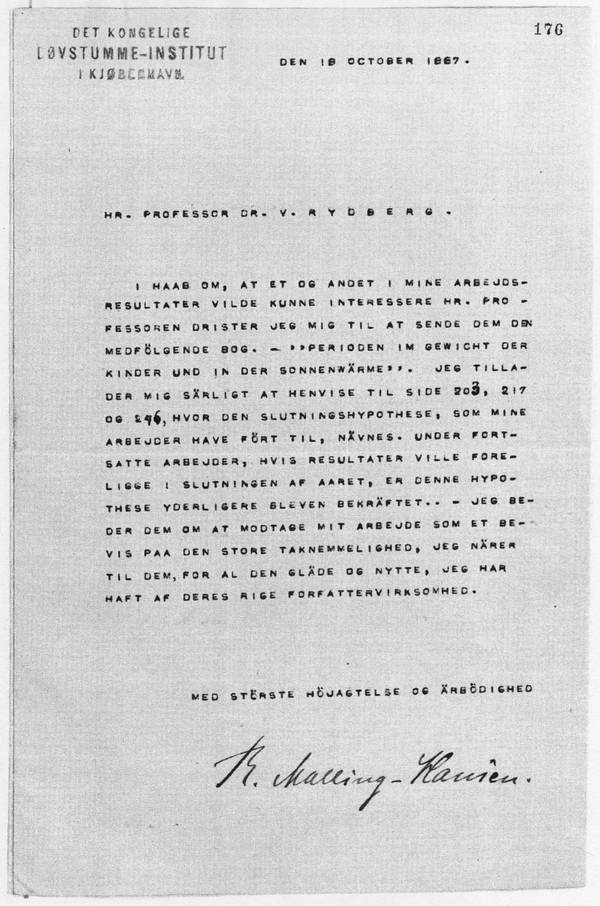1887.10.18 English
ROYAL INSTITUTE
FOR THE DEAF-MUTES OCTOBER 18, 1887[1]
COPENHAGEN
DEAR DR V. R Y D B E R G[2]
HOPING THAT ONE OR TWO THINGS AMONG THE RESULTS OF MY WORK MIGHT BE OF INTEREST TO YOU, DEAR PROFESSOR, I VENTURE TO SEND YOU THE ENCLOSED BOOK: “PERIODEN IM GEWICHT DER KINDER UND IN DER SONNENWÄRME”.[3]
IN PARTICULAR, SIR, I TAKE THE LIBERTY TO REFER YOU TO PAGES 203, 217 AND 246, WHERE THE CONCLUDING HYPOTHESIS OF MY WORK IS MENTIONED.
IN THE COURSE OF CONTINUED WORK, THE RESULTS OF WHICH WILL BE AVAILABLE TOWARDS THE END OF THE YEAR, THIS HYPOTHESIS HAS BEEN FURTHER CONFIRMED.
- SIR, I KINDLY REQUEST YOU TO ACCEPT MY WORK AS EVIDENCE OF THE GRATITUDE IN WHICH I HOLD YOU, FOR ALL THE PLEASURE AND BENEFIT THAT YOUR RICH LITERARY ACTIVITIES HAVE BROUGHT ME[4].
I REMAIN, SIR, YOUR OBEDIENT SERVANT
R. Malling-Hansen
[1] This is the first of three letter to professor Rydberg – the other two are 18871126UK and 18871128UK
[2] For facts about Victor Rydberg, please see below
[3] CB: This is the German edition of RMH’s giant work from 1886: ”Periods in the Growth of Children and Solar Heat”
[4] See Rydberg’s bibliography in the fact sheet. Four of his novels were published in Danish during RMH’s lifetime (and all other works in Swedish were certainly also accessible to him)

- Viktor Rydberg, 1828-1895, on a photo from 1880

- The German edition of Malling-Hansen's lecture at the Medical Congress in Copenhagen in 1884 - Tägliche Wägungen, published in 1884. Copyright: Private
FACTS ABOUT VIKTOR RYDBERG:
Abraham Viktor Rydberg (1828-1895) was a Swedish writer, poet, journalist, linguist, religious philosopher and cultural historian. Today, he is mostly known and remembered for his novel Singoalla and for Tomten, a work of poetry. He is regarded as Sweden’s most important writer and cultural celebrity between the two other giants Carl Jonas Love Almqvist (1793-1866) and August Strindberg (1849-1912).
VR took a strong interest in magic and in pre-Christian religious beliefs. The Swedish section of the Theosophical Society was founded in Rydberg’s home, but he himself never became a member (the Thesophical movement was to become a part of the spiritualistic movement, and in Germany in 1912 Rudolf Steiner broke loose from the society and founded what has now become the much more widely spread and well-known Anthroposophic Movement). Rydberg became famous – and in some circles notorious – for the fact that he denied the divine nature of Jesus Christ. His work “On the Nature of Christ According to the Bible” was published in Sweden in 1862, at a time when Swedish citizens did not yet enjoy freedom of religious choice. Rydberg advocated religious freedom and for the separation of the church from the state – two reforms that were brought about only in 1952 and 2000, respectively.
For many years Rydberg was a journalist; he was a member of Parliament 1870-72. Lectured at university level in the subjects of Philosophy and Cultural History 1876-80. 1877 honorary doctor at Uppsala University and that year he also became a member of the prestigious Swedish Academy. Professor of Cultural History at the University of Stockholm 1884. Member of the Royal Academy of Free Arts in 1887 and of the Royal Swedish Academy of Sciences in 1889.
Many of Rydberg’s works were published in several rather different editions over the years, because he was never totally satisfied with his works and continued to make alterations in the manuscripts over the years. The titles published during his own lifetime (al in Swedish) were:
- “The Itinerant Students”, 1856, novel
- “The Pirate in the Baltic Sea”, 1857/1866/1877, novel (Danish translation 1858/1875/1906)
- “Singoalla”, 1857/1865/1876/1894, novel (in Danish 1866/1895)
- “The Last Athenian”, 1859/1866/1876/1880/1892, novel (in Danish 1874/1906)
- “On the Nature of Christ According to the Bible”, 1862/1868/1880, theological thesis- “Magic in the Middle Ages”, 1865/1893, cultural history
- “Roman Legends about the Apostles Peter and Paul”, 1874, stories
- “The Adventure of Little Vigg on Christmas Eve”, 1871/1875, fairy tale (in Danish 1900)
- “Faust”, 1876/1878, translation into Swedish of Goethe’s versified drama
- “Roman Days”, 1877, cultural history
- “Poems: First Volume”, 1882
- “Investigations into Germanic Mythology” in two parts, 1866/1889, mythology
- “The God Saga of our Forefathers”, 1887, mythology
- “The Armourer”, 1891, novel (in Danish 1892/1906)
- “Poems: Second Volume”, 1891- “Varia”, 1894, mixed genre.
Looking at the time periods, this means that RMH in principle has been able to read a considerable part of Rydberg’s production, of which three in Danish translation. It is also highly likely that RMH was able to read Rydberg in Swedish. He must certainly also have known VR through Danish newspapers and the public debate of his time.
Jørgen Malling Christensen

